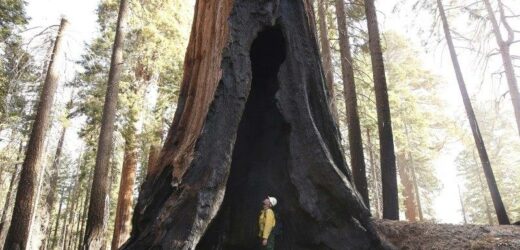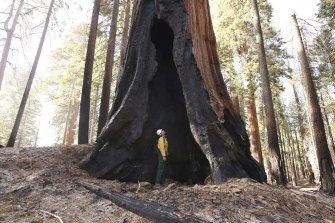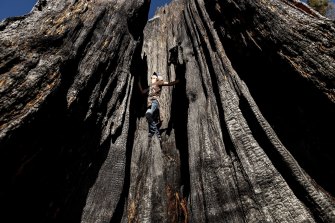Los Angeles: Lightning-sparked fires killed thousands of giant sequoias this year, leading to a staggering two-year death toll that accounts for up to nearly a fifth of Earth’s largest trees, officials say.
Fires in Sequoia National Park and surrounding Sequoia National Forest tore through more than a third of groves in California and torched an estimated 2261 to 3637 sequoias, which are the largest trees by volume.
Leif Mathiesen of the Sequoia & Kings Canyon Nation Park Fire Service looks at a burned-out giant sequoia from the Redwood Mountain Grove in the Kings Canyon National Park, California, an area ravaged by fires earlier in the year.Credit:Gary Kazanjian
Nearby wildfires last year killed an unprecedented 7500 to 10,400 giant sequoias that are only native in about 70 groves scattered along the western side of the Sierra Nevada range. Losses now account for 13 per cent to 19 per cent of the 75,000 sequoias greater than 1.2 metres in diameter.
Blazes so intense to burn hot enough and high enough to kill so many giant sequoias – trees once considered nearly fire-proof – puts an exclamation point on climate change’s impact. A warming planet that has created hotter droughts combined with a century of fire suppression that choked forests with thick undergrowth have fuelled flames that have sounded the death knell for trees dating to ancient civilisations.
“The sobering reality is that we have seen another huge loss within a finite population of these iconic trees that are irreplaceable in many lifetimes,” said Clay Jordan, superintendent of Sequoia and Kings Canyon National Parks. “As spectacular as these trees are we really can’t take them for granted. To ensure that they’re around for our kids and grandkids and great grandkids, some action is necessary.”
California has seen its largest fires in the past five years. Last year set a record for most acreage burned and this year, so far, is running second.
Ashtyn Perry, 13, climbs a scorched sequoia tree in Sequoia Crest, California. Credit:AP
Tree deaths this year might have been worse if heavy rain and snow October 25 hadn’t dampened the fire. Fires burned from August last year into January.
After last year’s Castle and SQF Complex fires took officials by surprise – and drove some tree lovers to tears – extraordinary measures were taken to save the largest and oldest trees this year.
The General Sherman tree – the largest living thing on earth – and other ancients that are the backdrop for photos that rarely capture the grandeur and scale of the giant sequoias were wrapped in foil blankets.
A fire-retardant gel, similar to absorbent used in baby’s nappies, was dropped on canopies that can sit above 60 metres tall. Sprinklers watered trunks and flammable matter was raked away from trees.
The measures helped spare the Giant Forest, the premiere grove of massive trees in the park, but the measures couldn’t be deployed everywhere.
The bulk of the Suwanee grove in the park burned in extreme fire in the Marble Fork of the Kaweah River drainage. The Starvation Complex of groves in Sequoia National Forest was largely destroyed.
The greatest amount of damage was done in Redwood Mountain Grove in Kings Canyon National Park. The inferno became so intense it created a fire cloud that whipped up 97 kmh winds.
A fire ecologist accurately predicted the areas that would burn hottest, but nothing could be done in such erratic conditions to save trees in the second-largest grove, said Christy Brigham, chief of resource management and science for the parks.
“That’s even more heartbreaking to me that we knew it and we couldn’t take action to protect it,” Brigham said.
Groves with the worst damage stand like timber graveyards with blackened trunks soaring high in the sky. Canopies have faded from vibrant green to a rusty shade. Many damaged trees are expected to perish in three to five years.
Save the Redwoods League, which lost the Waterfall tree – one of the world’s largest – in 2020, suffered losses this year in its Red Hill Grove.
“We need to call this situation in the giant sequoia what it is: an emergency,” said league President Sam Hodder. “Just a few years ago, it was considered unprecedented to lose a handful of giant sequoia to wildfire in a season, but now we’re losing thousands.”
In 2013, the park had done climate modelling that predicted extreme fires wouldn’t jeopardise sequoias for another 50 years, Brigham said. But that was at the start of what became a punishing five-year drought that essentially broke the model.
Amid the drought in 2015, the park saw giant sequoias torched for the first time. Two fires in 2017 killed more giant sequoias. Just over 200 giant sequoias were killed in the fires that served as a warning for what was to come.
“Then the Castle Fire happened and it was like, ‘Oh, my God,’” Brigham said. “We went from the warning sign to hair on fire. To lose 7000 trees in one fire is crazy.”
An accurate mortality count from last year is not available because crews were confirming how many trees died when lightning struck September 9, igniting the Windy Fire in Sequoia National Forest and two fires that merged to become the SQF Complex in the park, Brigham said.
Not all the news in the park’s report on the fires was bleak.
While flames burned into 27 groves and large numbers of trees were incinerated, a lot of low-intensity fire that sequoias need to thrive will clear out vegetation and the heat from flames will open cones so they can spread their seeds.
There was also less damage in many of the groves where the park has routinely used prescribed fire to clear out accumulated vegetation under cooler and more humid conditions. Those successes emphasised the need to expand that work and, where that’s too risky, begin thinning forests, Jordan said.
However, areas where fire burned so hot that seeds were killed and trees can’t regenerate may need additional help. For the first time, the park is considering planting seedlings to preserve the species.
“I’m not ready to give up on giant sequoias,” Brigham said. “This is a call to action to better protect the remaining old growth and make our Sierra Nevada forests wildfire resilient, because the fire’s coming.”
If seedlings are planted, though, it will take hundreds of years to replace the trees that were lost.
AP
Most Viewed in World
From our partners
Source: Read Full Article




